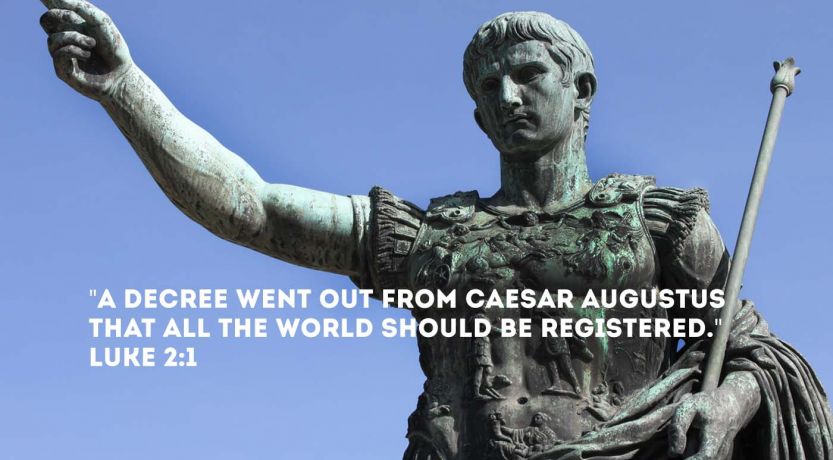Luke was a careful writer, and his Gospel is a part of inspired Scripture. So why doesn’t his account of the census of Quirinius seem to match other histories?

“And it came to pass in those days that a decree went out from Caesar Augustus that all the world should be registered. This census first took place while Quirinius was governing Syria” (Luke 2:1-2). Was Luke wrong about the timing of the birth of Jesus?
We believe that the Bible is the inspired Word of God (2 Timothy 3:16) and that the Bible is true and accurate. So when some scholars question the facts of the Bible, such as the timing of the census of Quirinius, we feel it is worth exploring further. We believe all apparent contradictions in the Bible have one or more explanations, though we can’t always be sure exactly which explanation is the correct one.
What the Bible says about the census of Quirinius
Luke the physician was a careful researcher who included various historical details in his two books, the Gospel of Luke and the Acts of the Apostles.
In setting the scene for the birth of Jesus Christ, Luke wrote:
“And it came to pass in those days that a decree went out from Caesar Augustus that all the world should be registered. This census first took place while Quirinius was governing Syria. So all went to be registered, everyone to his own city” (Luke 2:1-3).
Because of this census (held mainly to facilitate the collection of taxes), Joseph and Mary traveled to Joseph’s ancestral home in Bethlehem, where Jesus was born.
However, “outside the Scripture, ancient records tie Quirinius to a census only in A.D. 6, but this is too late to be the one referred to here” (NKJV Study Bible, note on Luke 2:1-2).
Why is A.D. 6 considered too late?
What year was Jesus born?
The Bible gives various markers that have been used to try to determine the year Jesus was born, but it does not give a date. Many biblical scholars have used outside historical information to narrow the year down to between 6 and 4 B.C. (Britannica, “Jesus”).
One of the main biblical markers is that Jesus’ birth was near the end of Herod the Great’s life. The Bible tells us that King Herod interrogated the “wise men from the East” about the birth of the “King of the Jews,” and sent them on to Bethlehem. But when the wise men didn’t return to tell him where the baby was, the jealous king ordered the murder of all baby boys 2 years old and under in the area of Bethlehem (Matthew 2:1-18).
Joseph and Mary took Jesus to Egypt to escape Herod, but returned when King Herod died (verse 15). Most historical sources date the death of Herod to 4 B.C. Josephus recorded a key event towards the end of Herod’s life: “an eclipse of the moon” (The Antiquities of the Jews, 17.167). This eclipse is dated March 13, 4 B.C.
However, as we have seen, a 4 B.C. date for Jesus’ birth has led some to question Luke’s account. Was Luke wrong about the census of Quirinius coming before the birth of Jesus?
When was Quirinius governor of Syria?
What do biblical scholars say about Quirinius? He was “Roman legate of the province of Syria (which included the sub-province of Judaea, but not Galilee) in 6 CE. Luke seems to have thought that he ordered a census at the time of the death of Herod in 4 BCE” (Oxford Biblical Studies Online, “Quirinius”).
According to the Holman Bible Dictionary, “his full name is Publius Sulpicius Quirinius. Throughout his varied career, Quirinius served as consul of Rome, military leader, tutor to Gaius Caesar, and legate (governor). He died in A.D. 21.
Some propose that Quirinius might have been governor twice. A more nuanced answer could be that he governed twice, though not actually having the title of governor twice.
“Luke’s reference to Quirinius as governor during the nativity has caused some scholars to question Lucan historical accuracy. It is established that Quirinius was legate in Syria from A.D. 6-9, but this date is far too late for Jesus’ birth, which occurred prior to the death of Herod the Great who died in 4 B.C. Luke’s historical reference seems in direct conflict with non-biblical sources establishing that either Saturninus (9-7 B.C.) or Varus (6-4 B.C.) was legate of Syria during Christ’s birth” (“Cyrenius”).
Was Quirinius governor of Syria twice?
The passage in Luke 2:2 states that “this census first took place while Quirinius was governing Syria.” So how can this be reconciled with the histories that show Quirinius being governor later, but not during the time before Herod the Great’s death?
Some propose that Quirinius might have been governor twice. A more nuanced answer could be that he governed twice, though not actually having the title of governor twice.
One good source that attempts to reconcile these issues is Gleason L. Archer’s New International Encyclopedia of Bible Difficulties. On pages 365-366, after clearly outlining the problem, Dr. Archer writes:
“By way of solution, let it be noted first of all that Luke says this was a ‘first’ enrollment that took place under Quirinius (haute apographe prote egeneto). A ‘first’ surely implies a second one sometime later. Luke was therefore well aware of that second census taken by Quirinius again in A.D. 7, which Josephus alludes to in the passage cited above. We know this because Luke (who lived much closer to the time than Josephus did) also quoted Gamaliel as alluding to the insurrection of Judas of Galilee ‘in the days of the census taking’ (Acts 5:37).”
Dr. Archer suggests that the first time Quirinius, who history shows was a military leader in the region at the time, might have been put in charge of the census even though he was not the governor.
This possible explanation allows for Quirinius’ involvement with two censuses, without being the official governor the first time.
Another possibility
Another possibility is that Luke 2:2 could be translated differently.
“It is possible that Luke 2:2 reads, ‘This census took place before Quirinius was governing Syria.’ In this case, the Greek word translated ‘first’ (protos) is translated as a comparative, ‘before.’ Because of the awkward construction of the sentence, this is not an unlikely reading” (Norman Geisler and Thomas Howe, When Critics Ask: A Popular Handbook on Bible Difficulties).
Other evidence for a 4 B.C. date for Jesus’ birth
Another marker for dates in Jesus Christ’s life is the prophecy given to Daniel in Daniel 9:24-27. This is referred to as the 70 weeks of Daniel, or the 70-weeks prophecy.
This prophecy is explained in detail in our articles “The Time Is Fulfilled: 4 Proofs Jesus Was Messiah” and “70 Weeks of Daniel: What Does the Prophecy Mean?” These articles show why we date the beginning of Jesus’ ministry, when He was 30 years old (Luke 3:23), to A.D. 27.
This dating fits with a 4 B.C. birth of Jesus, since there is no year 0 between B.C. and A.D.
The more important issue: why Jesus was born
There is not much in the Bible about Jesus’ birth. His birth is described in the New Testament in the Gospels of Matthew and Luke. The event is recorded in the Bible to show that the Word (John 1:1, 14), one of the two beings called “God,” became human and lived life from infancy until His death in His early 30s. We also read of His birth in Isaiah 9, where the Messiah is prophesied to be born as a human child.
The Bible focuses much more on Jesus’ life and teachings after He began His ministry at age 30. The story of His last 3½ years provides details of His life and death. Included in this time are His preaching of the good news of the Kingdom of God and His teachings on how we are to live our lives and how He intended for His New Testament Church to function. After living a perfect life, Jesus gave His life as a perfect sacrifice to pay for our sins.
Read more about why Jesus was born and His mission in our articles “The Incarnation: How Christmas Hides Its Meaning” and “What Was Jesus’ Message?”
For more on the accuracy of the Bible, download our free booklet Is the Bible True?





